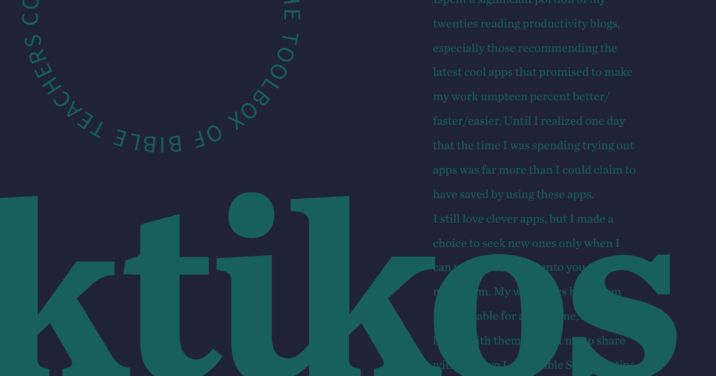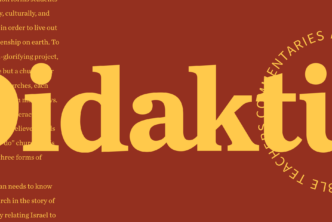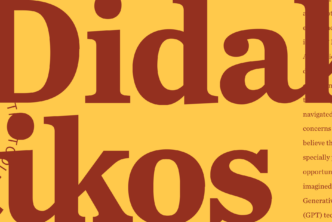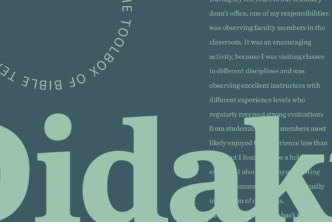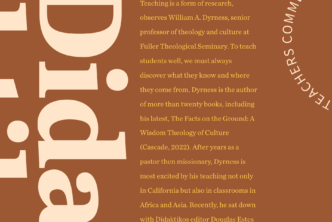Dustin Burlet | Peace River Bible Institute
T. Desmond Alexander once stated, with respect to teaching the Old Testament, that it is “difficult to think of any other academic subject that covers such a wide range of fields. How does one do justice to all the various areas that contribute in their distinct way to our understanding and appreciation of the Bible?”1 This assertation resonates deeply with me, as few of my “classroom conundrums” have required more circumspection and pastoral sensitivity than dealing with those matters that concern science, creation, and the Bible (history, literature, and theology), particularly with respect to the first eleven chapters of Genesis.2
As my instructing journey has evolved, however, I have discovered the benefits of offering students the chance to “choose their own adventure” through flexible “You Pick” projects—i.e., leveraging the pedagogical discipline of heutagogy (self-determined learning) as part of the syllabus requirements. These projects not only facilitate creativity, foster passion, and fuel curiosity but also lead to high(er) caliber work, increased student satisfaction, and more acute opportunities for self-confidence and insight, as students take ownership and buy in.
Heutagogy is the study of self-determined learning, whereby students move beyond curriculum bounded knowledge and skill acquirements towards building their capacity and capabilities. Students take responsibility for their own learning … set their own learning goals, in line with the course or programme outlines, and manage their own learning, again within set goals and guidelines.3
The function and purpose of You Pick projects is to help match a student’s unique background and degree specializations (biblical studies, general studies, etc.) with their own interest(s) and skill set(s) to enable them to better understand the biblical text itself.
A certain amount (roughly 75 percent) of the course grade remains devoted to non-optional and non-negotiable assignments (textbook readings, research papers, etc.) that I have predetermined are necessary for all students to learn and master, thus enabling all of the key aspects of course content to be adequately covered. The remainder of the course-credit assignment hours (roughly 25 percent) are then tailored according to specific, personal arrangements between the student(s) and myself. After student(s) and I discuss their ideas, we draft a “contract” that holds them to their commitment (however, some flexibility is always permissible).
The basics of the You Pick project process, as a whole, are as follows:
Near the beginning of the semester at a pre–appointed time, I ask students to submit what they would like to do for a You Pick project.
Students are highly encouraged to make special usage of the arts and/or other creative outlets. There is no skimping on imagination, wonder, or ingenuity.
The syllabus offers various templates students can leverage for ideas. They include personal photography, original video creations and/or critiques, drama productions (skits, mime, monologues, reenactments, puppet shows), astronomy, original artwork/art critique(s), poetry, prose, songs, clothing, sculptures, models, or preparing food associated with the ancient Near East.4
In addition to the project itself, all students are required to submit a brief summary explaining the project’s rationale (why the student chose to do this project), its background, and any symbolism or meaning that is not directly obvious. In addition, each student must describe how the assignment has impacted them personally and what they have learned and experienced as a result of the You Pick project. “Specific is terrific” is tattooed into their minds. It also has been of great import to my students for me to provide a clear grading rubric (via attachment) and to require some type of self-evaluation component.5 Lastly, if time and the medium/format allows, it usually proves beneficial if the students are able to share their projects with each other, thus enabling the entire class to glean from one another’s work.
EXAMPLES OF STUDENT-PICKED PROJECTS
Here are several examples of You Pick projects my students developed in conjunction with studying Genesis 1–11.
In a one-week modular course, one of my students wanted to engage more extensively with some of the finer points of theology concerning inerrancy, inspiration, and divine accommodation.6 Alongside her impressive exegetical work, she also sketched some of her own imaginative renditions of the process of creation and compared/contrasted various scholarly portrayals of day two of the creation week (Gen 1:6–9).7 At the end of the course, in her student evaluation—and later through a private message to me—the student reported that what she had learned outside the classroom had stuck with her and that she was better able to understand the arguments involved. She saw her own presuppositions in a new way, she said, because of the specific shape and alternative arrangement of the unique “choose your own adventure” assignment.
One of my classrooms was once home to a nearly-six-foot replica of Noah’s ark. Though for many people this Brobdingnagian structure defies naturalistic explanation, it was clear to me that the time-consuming construction process equipped the student to elucidate the complexities and intricacies of pitch, yaw, and roll (list and heel) with respect to the height, length, and width of the ark (see Gen 6:14–16). In my mind, it is one thing for a student to read and contemplate the fact that the great boat described in Scripture is often understood to be in the shape of something considered to be suitable for sea-faring—i.e., “a type of [nautical] vessel characterized by a comparatively narrow beam combined with considerable length of hull and shallowness of draught.”8 It is another thing altogether, however, to have the hands-on learning experience of what this might actually mean.9
On another note, I have never ceased to marvel at the exceptional vocal and musical talent that can often be found in my students. Though none of their scores or numbers have reached the same level of popularity of N. T. Wright and Francis Collins’s duet titled “Genesis!” (a rewritten rendition of the Beatles song “Yesterday”), I have always been pleased at their depth, quality, and theological astuteness, as well as the not-insignificant impact I have witnessed of their songs and lyrics in the students’ church and parachurch ministries (such as Christian camping).1010
A TEACHER-SUGGESTED “CHOOSE YOUR OWN ADVENTURE!”
Of course, not all students enjoy self-direction; some feel totally lost. Given such, I do offer some more-fleshed-out project suggestions. One example, for instance, has to do with what is among the most heated topics among my students (and Christians generally): the flood.
Esteemed Hebraist and biblical commentator Bruce K. Waltke observes that while many “evangelicals favor a local flood,” the Genesis “narrator, even allowing for oriental hyperbole, seems to have in mind a universal flood.”1111 Waltke lays out what have become the fault lines of the debate over Noah’s flood: “The geological arguments favoring a local flood assume that the history of the earth’s geo-logy is uniform, but the text represents a geological cataclysm and a re-creation of the earth.”12 My students particularly enjoy examining this problem, as it is something I had the privilege to explore at length via my dissertation work on the rhetoric of the Noachian deluge and a trip down the Grand Canyon to see some of the evidence for myself.
To put things more clearly, the innate geological characteristics of the Coconino sandstone, a particular rock layer of the Grand Canyon, give it the inimitable privilege of being considered the most powerful argument against the Noachian deluge. However, that the lay-accessible arguments that have been constructed from multiple reputable, evangelical geologists—from young-earth creationist perspectives (Answers in Genesis) as well as evolutionary creationist perspectives (BioLogos)—make clear that one need not be a scientist to lean into the debate.13 Not a few of my students said that engaging this topic was the highlight of the course.
STUDENTS PURSUE QUESTIONS THEY CARE ABOUT
In all honesty, it is not very hard to get students interested in the issues surrounding Genesis 1–11. Most can see immediately that debates about a historical Adam or about the discontinuity and continuum of various views—the Intelligent Design (ID) movement, Young-Earth Creationism (YEC), Old Earth (Progressive) Creationism, and Evolutionary Creation—are all extremely important and, therefore, interesting.14Many students tell me they have encountered rifts among Christians (and between Christians and philosophical materialists) over these issues.
Yet, if it’s true that people learn what they care about and remember what they understand, then “choose your own adventure” projects have made all the difference for me between a run-of-the-mill lesson and an unforgettable learning experience.15 They help me help students find the questions that they care about and pursue new levels of understanding in ways that are usually hampered through the constraints of most traditional assignments. In fact, I still remember the assignments I did as a student in Bible college that were aided by the principles of heutagogy. Perhaps that is why I am so passionate about the subject even today.
This article was first published in Didaktikos: Journal of Theological Education. Theological faculty can sign up for a free subscription here.
- T. Desmond Alexander, “A Religious Book in a Secular University,” in Make the Old Testament Live: From Curriculum to Classroom, ed. by Richard S. Hess and Gordon Wenham (Grand Rapids: Eerdmans, 1998), 97.
- See Kenneth J. Turner, “Teaching Genesis 1 at a Christian College,” in Reading Genesis 1–2: An Evangelical Conversation, ed. J. Daryl Charles (Peabody, MA: Hendrickson, 2013), 187. Cf. Randy Klassen, “Teaching Genesis to Young Adults,” Direction 43.1 (2014): 99–104; Paul E. Nynas, “What Are We Telling the Kids? Teaching Genesis to Teenagers,” Word and World 29.1 (2009): 56–62; K. Helmut Reich, “Teaching Genesis: A Present-Day Approach Inspired by the Prophet Nathan,” Zygon 38.3 (2003): 633–41; Richard Thomas Aquinas Murphy, “Panel Discussion on the Methods of Teaching Scripture 2: On Teaching Genesis,” CBQ 17.1 (1955): 36–38.
- Earna Oliver, “A Move Towards Heutagogy to Empower Theology Students,” Hervormde teologiese studies 72.1
(2016): 3. - For other examples of creative teaching (with biblical texts), see “Part 2: Hebrew Bible Torah,” in Teaching the Bible: Practical Strategies for Classroom Instruction, ed. Mark Ronacre and Patrick Gray (Atlanta: Society of Biblical Literature, 2005), 67–136.
- The key questions I believe need to be answered here include: (1) “What went well?,” (2) “What areas could have been improved?,” and, (3) “What was the significance/application of this project? What did I learn?” For more details on this point, see Wilbert McKeachie and Marilla Svinicki, McKeachie’s Teaching Tips, 14th ed. (Belmont, CA: Wadsworth, 2014), 73–84.
- Some recent volumes concerning this include: John W. Hilber, Old Testament Cosmology and Divine Accommodation: A Relevance Theory Approach (Eugene, OR: Cascade, 2020); Denis O. Lamoureux, The Bible and Ancient Science: Principles of Interpretation (Tullahoma, TN: McGahan, 2020); Carol Hill, A Worldview Approach to Science and Scripture (Grand Rapids: Kregel, 2019); Paul Copan and Douglas Jacoby, Origins: The Ancient Impact and Modern Implications of Genesis 1-11 (New York: Morgan James, 2019); C. John Collins, Reading Genesis Well (Grand Rapids: Zondervan, 2018); Kyle Greenwood, Scripture and Cosmology: Reading the Bible Between the Ancient World and Modern Science (Downers Grove, IL: IVP Academic, 2015); and Peter Enns, Inspiration and Incarnation: Evangelicals and the Problem of the Old Testament, 2nd. ed. (Grand Rapids: Baker, 2015). Cf. Terry Mortenson, “The Firmament: What Did God Create on Day 2?” Answers Research Journal 13 (2020): 113–33.
- A selective example of such depictions may be found in Copan and Jacoby, Origins, 215; Greenwood, Scripture and Cosmology, 26; Enns, Inspiration and Incarnation, 43; Lamoureux, Bible and Ancient Science, 33, 35, 109; Hill, Worldview Approach, 10; Collins, Reading Genesis Well, 245; and Mortenson, “The Firmament,” 127, 129–32.
- Raphael Patai, The Children of Noah: Jewish Seafaring in Ancient Times (Princeton: Princeton University Press, 1998), 4. See also Victor P. Hamilton, Genesis 1–17 (Grand Rapids: Eerdmans, 1990), 282; Bruce K. Waltke and Cathi J. Fredricks, Genesis: A Commentary (Grand Rapids: Zondervan, 2001), 135; and Kenneth Mathews, Genesis 1–11:26 (Nashville: B&H, 1996), 363. Cf. Tremper Longman III and John H. Walton, The Lost World of the Flood: Mythology, Theology, and the Deluge Debate (Downers Grove, IL: IVP Academic, 2018), 77; and Norman Cohn, Noah’s Flood: The Genesis Story in Western Thought (New Haven: Yale University Press, 1996),
38–133. - For further details on interactive, immersion-style, kinesthetic pedagogy (with a special emphasis on the book of Genesis), see Travis West, Roger S. Nam, and Amanda W. Benck-huysen, “Kinesthetic Language Learning: How an Accident Led to a Revelation,” Theology & Religion 19.4 (2016): 378–84.
- For more on the relationship between music, theology, and Christian learning, see Jeff Astley et al., eds., Creative Chords: Studies in Music, Theology, and Christian Formation (Leominster, UK: Gracewing, 2000) and Jeremy S. Begbie, Resounding Truth: Christian Wisdom in the World of Music, Engaging Culture (Grand Rapids: Baker Academic, 2007). For more on teaching the Bible with music, see “Part 1: Music,” in Teaching the Bible through Popular Culture and the Arts, ed. Mark Ronacre and Patrick Gray (Atlanta: Society of Biblical Literature, 2007), 7–86.
- Waltke and Fredericks, Genesis: A Commentary, 132–33.
- Waltke and Fredericks, Genesis: A Commentary, 133.
- See, for example, Stephen O. Moshier et al., “Flood Geology and the Grand Canyon: What Does the Evidence Really Say?” BioLogos, https://biologos.org/articles/flood-geology-and-the-grand-canyon-what-does-the-evidence-really-say; John H. Whitmore, “The Coconino Sandstone: The Most Powerful Argument Against the Noahic Deluge?” Answers in Genesis, https://answersingenesis.org/geology/grand-canyon/coconino-sandstone-most-powerful-argument-against-flood/. Cf. Stephen O. Moshier, “Proposition 15: Geology Does Not Support a Worldwide Flood,” in Longman and Walton, Lost World, 150–61; Davis A. Young and Ralph R. Stearley, The Bible, Rocks, and Time (Downers Grove, IL: IVP Academic, 2008), 215–17, 224–30, 304–8; David R. Montgomery, The Rocks Don’t Lie: A Geologist Investigates Noah’s Flood (New York: W. W. Norton, 2012), 25–27; Carol Hill et al., eds., The Grand Canyon: Monument to An Ancient Earth: Can Noah’s Flood Explain the Grand Canyon? (Grand Rapids: Kregel, 2016); and John H. Whitmore, “Sand Injectites at the Base of the Coconino Sandstone, Grand Canyon, Arizona,” and “Characterization of Hard-to-Differentiate Dune Stratification Types in the Permian Coconino Sandstone (Arizona, USA),” https://digitalcommons.cedarville.edu/sw_gallery.html.
- To this end, I have found the Counterpoints: Bible and Theology series (Grand Rapids: Zondervan Academic) to be quite useful in facilitating student-led symposiums, colloquies, debate teams, or for students writing “point-counterpoint” argument papers. In particular, the following volumes have been helpful: Charles Halton, ed., Genesis: History, Fiction, or Neither? Three Views on the Bible’s Earliest Chapters (2015); Ardel Caneday and Matthew Barrett, eds., Four Views on the Historical Adam (2013); J. B. Stump, ed., Four Views on Creation, Evolution, and Intelligent Design (2017); J. P. Moreland and John Mark Reynolds, eds., Three Views on Creation and Evolution (1999); and Paul Copan and Christopher L. Reese, Three Views on Science and Christianity (2021).
- See Robert DeVargas, “Creating an Unforgettable Learning Experience,” in The Teaching Ministry of the Church, 2nd ed., ed. by William R. Yount (Nashville: B&H Academic, 2008), 262.

